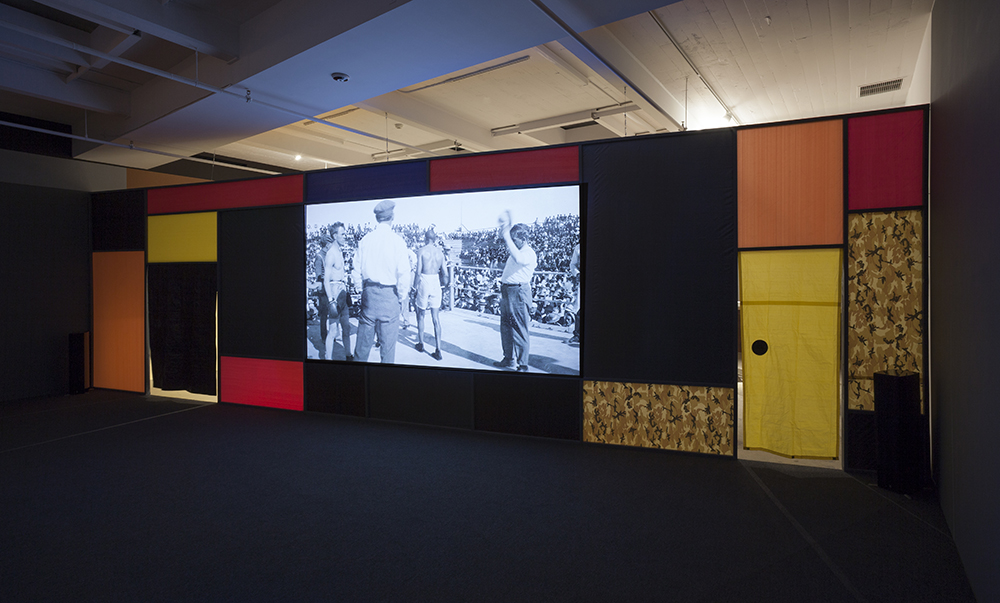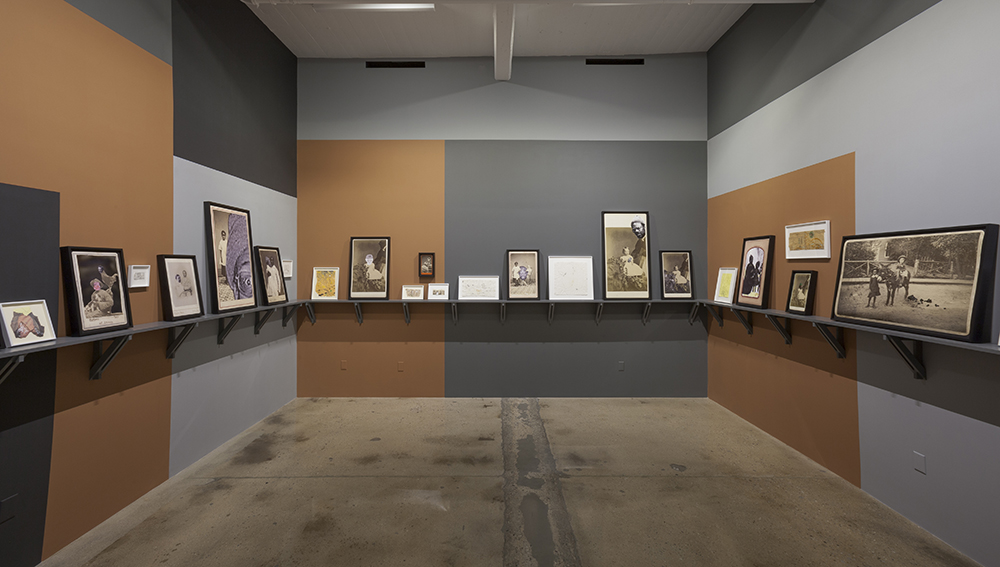By Lauren McQuade
Stark rattling creeps in. After a few seconds, an initial pang of sound smooths into a pervasive noise that induces a feeling of anxious, indistinguishable energy. Did I walk into the gallery’s theater feeling like this?, I think to myself, but I can’t recall. Old black and white images of the desert alternate between present day images of the same scene; the now diffused rattling rolls into booming drums when a large magenta font flashes onscreen: OBI SUNT
“Blackness feels personal, like something we can own or hold in our hands or hang from a tree. Therefore, we mistake it for the dance when it’s really the hollow inside the drum.”
—Pope.L, Some notes on the Desert
Obi Sunt is a new film by Chicago-based artist William Pope.L, combining footage of the artist with black and white images from a rare photo album that documents the legendary 1906 boxing match in Goldfield, Nevada, between Joe Gans, an African American fighter known as “The Master,” against “The Durable Dane,” a white fighter named Oscar “Battling” Nelson that lasted an agonizing 42 rounds.
“I’m not interested in who won,” Pope.L said after screening the film. “I mean, I was at first, because I always want black people to do well, but at the same time, after a while, that’s all there is.”
The video projection is part of the exhibition Desert, which opened October 17 at Steve Turner Contemporary, and also includes a new set of photographs entitled Servants, re-photographed and manipulated 19th century photographs of black caretakers. Some of the images look as if Pope.L traveled back in time and photo-bombed the old portraits; two groups of new sculpture are also included: Erasers (2015) and Packages Received But Never Opened (2015).
Pope.L also chose to include some older works—Failure Drawings (2004-06), a series created with only found materials he had on hand while traveling, and Nigger Eraser (1998), made out of a container of deodorant—though most of the pieces shown in Desert were made within the last 12 months, showing where his mind has been lately.
Steve Turner introduced the video, telling the audience we were the first observers of Obi Sunt. In outlining Pope.L’s extensive bio—he’s been making art since the 1970s—he described the artist as having “done everything there is to do in the art world,” from performance, to the written and spoken word, to making every kind of object (painting, drawing, sculpture, photography), all of which are present throughout Desert.
Pope.L is perhaps best known for his performance-based series of staged “crawls” dating back to 1978 in New York during his 20s. While studying art in graduate school at Rutgers, not far from his hometown of Newark, NJ, the young artist started voluntarily surrendering his own verticality in an attempt to bring attention to poverty and homelessness by crawling, inch by inch, on the city’s streets, literally positioning himself on the level of those most marginalized.
While remaining flush with the pavement, he crawled through Tompkins Square in 1991 sporting a business suit, using only his elbows and knees to propel him forward. During a project called The Great White Way, he wore a Superman costume while crawling up Broadway over the course of 9 years and 22 miles.
After screening Obi Sunt, I ask if his intensions for producing work have remained the same throughout his long-standing career; he answered with a decided, “No.”
This is probably the first work I’ve made about a black male body since the 90s, maybe, because at the time I was being characterized as the artist who did that, so I avoided it. I knew that my crawling in the street at that time was not just about black bodies it was about poor people, about homeless people, they could be any dimension or color—But, you know, people being people, people sort of hooked onto that, but I felt after x number of years, you know, that, and becoming a father—
He paused, then continued:
This is Gans in a way. You can say it’s this person’s patrilineal hookup, you know, that it’s a shadow in which this person is walking and that’s part of the problem, if you will, these shadows that precede us.
Pope.L was made aware of the historic fight between Gans and Nelson, now considered to be a precursor to contemporary boxing, after getting to know Steve Turner, who let him see the 1906 album from Turner’s extensive photo archive. From there, his challenge emerged: “How do I make it clear that at the time that this record was made, the people who created the record had their own agenda? So I decided not to be true to the album.”
He decided the best (i.e., most inclusive) way to represent the album that disproportionately documented the white fighter, Nelson, and eschewed Gans, was to give the album its due. He made clear the album’s actual contents, to some extent, but added his own counter stories that would interact with the mythology that surrounds the resurrection of the past through biography, and thus began his one-man, one-shoed journey portrayed in the video.
“I asked myself as a black person, what is my ownership of Gans? Just because I’m black I have an ownership? Hmm, why is that?” he said.
Did you figure it out?
“Sure.”
Is that what we just watched?
“Yep.”
Desert is set against a second Pope.L exhibition that opened on October 23 at Susanne Vielmetter Los Angeles Projects called Forest and will run simultaneously as a companion show. Forest, in contrast, will feature paintings and sculptures in an architectural installation surveying the artists’ object-based practice, the oldest work is from 1997 and goes through the present.
Together, Desert and Forest are the multidisciplinary artist’s first solo exhibitions following Trinket, his acclaimed exhibition at MOCA, Los Angeles, earlier this year.
Beginning November 7, two Los Angeles artists will lead concurrent walking tours, one leaving from Susanne Vielmetter Los Angeles Projects, the Forest, going to Steve Turner, the Desert, and vice versa—a 6 mile trek. (Plan shoe choice accordingly.)
“It was important to Pope.L that the artists who are leading the tour bring their own interpretation to it, so each of these tours is different,” said Owner/Director Susanne Vielmetter. In addition to the walking tours, there is a downloadable GPS driving tour that allows the listener to hear Pope.L speak about the forest with a brief section about the desert while driving from one gallery to the other.
“I think having seen the MOCA show and seeing these two shows, the three shows together will really give a better idea of how wide his practice is reaching,” said Vielmetter.
“The shows at Susanne Vielmetter and Steve Turner are an attempt to navigate a clunky space strewn with notions such as project, art object, concept, and oeuvre by hopping from one bit of life to another—building a set of rafts made of flotsam and jetsam in the form of artworks and notions that did not initially or intentionally belong together, along the way. At first, I thought this hubris and folly. Now I understand my real folly was believing there was any other way.”
—Pope.L, Some notes on the Desert
—Lauren McQuade



